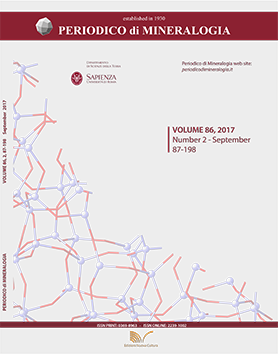Evolution of Nb-mineralization in the Chuktukon carbonatite massif, Chadobets upland (Krasnoyarsk Territory, Russia)
DOI:
https://doi.org/10.2451/2017PM733Keywords:
pyrochlore, rippite, rutile, goethite, carbonatite, carbonatite deposit, weathering crust, Krasnoyarsk territory, niobiumAbstract
This paper reports on new study of the niobium mineralization of the Chuktukon carbonatites and weathering crust. The Chuktukon massif is located within the Chadobets upland in the southwestern part of the Siberian Platform. Primary Nb-minerals of carbonatites are pyrochlore group minerals (mainly fluorcalciopyrochlore), newly discovered mineral - rippite (K2(Nb,Ti)2(Si4O12)O(O,F)), and Nb-rutile. Fluorcalciopyrochlore has oscillatory zonation with variations in content of Nb2O5 (59-67 wt.%), TiO2 (2.8-5 wt.%), SiO2 (up to 3.3 wt.%), CaO (15.9-17.7 wt.%), Na2O (7-8.2 wt.%) and F (4.5-5.13 wt.%). Rippite is Nb-rich silicate (~44 wt.% of Nb2O5) and contains inclusions of primary fluorcalciopyrochlore. Nb-rutile form oscillatory and sectorial hourglass-like zoned crystals with variable content of Nb2O5 (9-14.7 wt.%). The carbonatites underwent strong hydrothermal alteration and subsequent weathering, and, as a result, in the hydrothermally altered carbonatites and weathering crust the primary Nb-minerals become unstable, dissolve and decompose, and Nb-bearing goethite (up to 4.3 wt.% of Nb2O5) formed. Primary fluorcalciopyrochlore is replaced by the secondary Sr-, Pb-, LREE- and Ba-rich pyrochlore group minerals.


